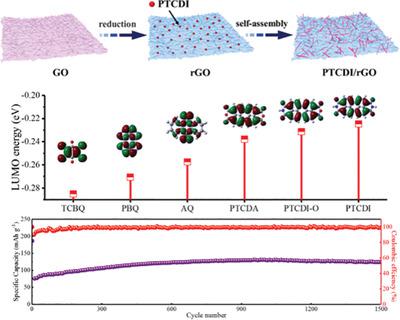Our official English website, www.x-mol.net, welcomes your
feedback! (Note: you will need to create a separate account there.)
Building High Rate Capability and Ultrastable Dendrite-Free Organic Anode for Rechargeable Aqueous Zinc Batteries.
Advanced Science ( IF 14.3 ) Pub Date : 2020-06-25 , DOI: 10.1002/advs.202000146 Nannan Liu 1 , Xian Wu 1 , Yu Zhang 1 , Yanyou Yin 1 , Chengzhi Sun 1 , Yachun Mao 1, 2 , Lishuang Fan 1, 2 , Naiqing Zhang 1, 2
Advanced Science ( IF 14.3 ) Pub Date : 2020-06-25 , DOI: 10.1002/advs.202000146 Nannan Liu 1 , Xian Wu 1 , Yu Zhang 1 , Yanyou Yin 1 , Chengzhi Sun 1 , Yachun Mao 1, 2 , Lishuang Fan 1, 2 , Naiqing Zhang 1, 2
Affiliation

|
Aqueous zinc‐ion batteries (ZIBs) are an alternative energy storage system for large‐scale grid applications compared with lithium‐ion batteries, when the low cost, safety, and durability are taken into consideration. However, the reliability of the battery systems always suffers from the serious challenge of the large Zn dendrite formation and “dead Zn,” thus bringing out the inferior cycling stability, and even cell shorting. Herein, a dendrite‐free organic anode, perylene‐3,4,9,10‐tetracarboxylic diimide (PTCDI) polymerized on the surface of reduced graphene oxide (PTCDI/rGO) utilized in ZIBs is reported. Moreover, the theoretical calculations prove the reason for the low redox potential. Due to the protons and zinc ions coparticipant phase transfer mechanism and the high charge transfer capability, the PTCDI/rGO electrode provides superior rate capability (121 mA h g−1 at 5000 mA g−1, retaining the 95% capacity of that compared with 50 mA g−1) and a long cycling life span (96% capacity retention after 1500 cycles at 3000 mA g−1). In addition, the proton coparticipation energy storage mechanism of active materials is elucidated by various ex‐situ methods.
中文翻译:

为可充电水系锌电池构建高倍率能力和超稳定的无枝晶有机阳极。
与锂离子电池相比,水系锌离子电池(ZIB)是一种适合大规模电网应用的替代能源存储系统,考虑到低成本、安全性和耐用性。然而,电池系统的可靠性始终受到大锌枝晶形成和“死锌”的严峻挑战,从而导致循环稳定性较差,甚至电池短路。本文报道了一种无枝晶的有机阳极,即在 ZIB 中使用的还原氧化石墨烯 (PTCDI/rGO) 表面聚合的苝-3,4,9,10-四甲二酰亚胺 (PTCDI)。此外,理论计算证明了氧化还原电位低的原因。由于质子和锌离子共同参与的相转移机制和高电荷转移能力,PTCDI/rGO电极提供了优异的倍率性能(5000 mA g -1 时为121 mA hg -1 ,与50 mA g -1相比,保留了95%的容量) mA g -1)和长循环寿命(3000 mA g -1下1500次循环后容量保持率为96% )。此外,通过各种异位方法阐明了活性材料的质子共参与储能机制。
更新日期:2020-07-22
中文翻译:

为可充电水系锌电池构建高倍率能力和超稳定的无枝晶有机阳极。
与锂离子电池相比,水系锌离子电池(ZIB)是一种适合大规模电网应用的替代能源存储系统,考虑到低成本、安全性和耐用性。然而,电池系统的可靠性始终受到大锌枝晶形成和“死锌”的严峻挑战,从而导致循环稳定性较差,甚至电池短路。本文报道了一种无枝晶的有机阳极,即在 ZIB 中使用的还原氧化石墨烯 (PTCDI/rGO) 表面聚合的苝-3,4,9,10-四甲二酰亚胺 (PTCDI)。此外,理论计算证明了氧化还原电位低的原因。由于质子和锌离子共同参与的相转移机制和高电荷转移能力,PTCDI/rGO电极提供了优异的倍率性能(5000 mA g -1 时为121 mA hg -1 ,与50 mA g -1相比,保留了95%的容量) mA g -1)和长循环寿命(3000 mA g -1下1500次循环后容量保持率为96% )。此外,通过各种异位方法阐明了活性材料的质子共参与储能机制。











































 京公网安备 11010802027423号
京公网安备 11010802027423号